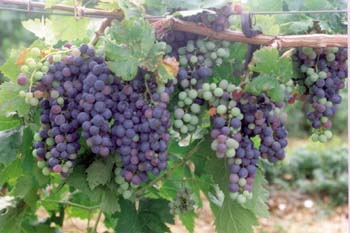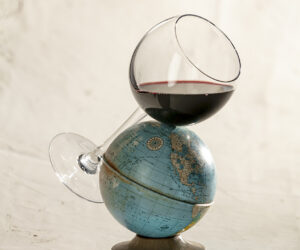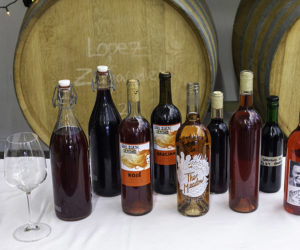
In Spain, where many historians claim the variety originated, this versatile grape is called Garnacha. The rest of the world calls it Grenache … and home winemakers call it a great grape to work with. This red vinifera grape allows the home winemaker to make a variety of different wine styles, all of which are pleasant and easy to drink.
The Grenache grape variety is highly recommended for the home winemaker. The variety is readily available in fresh-grape form and the price is usually at the lower end of the fresh-grape scale. Processed Grenache juice, Grenache kits and Grenache concentrates are also readily available at moderate prices.
Making wines from Grenache is a reasonably easy, straightforward process and the results are usually rewarding. The variety also lends itself to a wide range of experimental wine styles. There are many options for using the white wine made from Grenache, particularly as a blending partner to other wines. Grenache wines with a high alcohol content can perk up lower-alcohol, thinner wines. A natural partner of Grenache is Syrah, as the marriage offers an outstanding red table wine. And don’t forget the fresh, fruity rosé wines made from Grenache. For all of these reasons, I recommend that winemakers make some wine from Grenache each year.
Grenache Plantings
Whatever its origin, Grenache is the second most-planted grape variety in the world. In Spain, it is also called Garnacha Tito or Garnacha Tina and the varietal does particularly well in the arid conditions in that country. Grenache occupies more vineyard acres than any other variety in Spain, totaling 250,000 acres under vine. France’s Grenache vineyards total more than 200,000 acres. In those countries, however, Grenache is used mainly as a blending variety and its name is rarely associated with the many wines it helps to bolster.
Grenache is one of the primary wines used in the blending process of making the famous Chateauneuf-du-Pape in Southern France. The variety is also the primary wine in making Tavel and Lirac, two of the most famous rosé wines of France.
In Cyprus, a wine called Kykko — considered a new generation of Cyprus wines — is made from a blend of Grenache and Carignane. And in Australia, where the blending of different wines is legend, Grenache and Shiraz are united to produce a magnificent red table wine.
The Grenache grape is popular in other regions of the world, including the countries of Morocco, Algiers, South Africa, Australia, Chile, Argentina, Israel and Italy. And, of course, Grenache is popular in the United States, where California growers have planted over 13,000 acres.
Grenache’s Traits
Much of Grenache’s popularity is due to its prolific growing habits in poor soils, particularly in warm, dry and windy climates. It buds early and, if left on the vine for late harvesting, it reaches high sugar levels (to the upper 20’s in Brix counts). This allows winemakers to make high-alcohol wines. This growing strategy is another of the reasons for the grape’s versatility.
Grenache’s vines are strong and rigid and, in this day of mechanical harvesting, the variety is not well-suited to this technique. The vines have little elasticity, which is a must for mechanical harvesting, as the vines often break from the vibrating pressure of the harvesters. This is one of Grenache’s few drawbacks.
Grenache likes hot, dry-climate areas. When the grape is irrigated, it loses some of its potency, complexity and flavors. It can tolerate sustained summer temperatures of 100° F (37.7° C) and rainfall in amounts as little as 10 inches per year.
When fully ripe, Grenache features very fruity flavors — predominately strawberry — coupled with a fiery spiciness. Grenache wine styles can vary from light-bodied, delicious, fruity rosés to rich, red, table wines, to full dessert and fortified wines.
Many home winemakers make full-bodied Grenache wines, with alcohol levels up to 15 percent. However, this type of wine will require extensive aging in the cellar before it is drinkable, or at least pleasantly approachable. The choices of style are many and its versatility is a feature of the variety.
Grenache and Vermouth
The French vermouth industry uses Grenache blended with Muscat to make its world-famous dry vermouth wines. These are used as aperitifs and as blending partners for the popular cocktail, the martini. This use for the Grenache is interesting, and — for those who like to experiment — it could make an intriguing and challenging assignment. Although we have seen some vermouth-type wines in amateur competitions, it is not a common entry. The secret to making outstanding vermouth wines is the addition of herbs and botanicals as a flavoring agents.
We don’t have the formulas for vermouth as they are kept secret and handed down from generation to generation. We do know the identity of some of these ingredients, but not the quantities in which they are used. This is where your own experimentation would come in.
If you decide to make a dry vermouth, make your Grenache like a white wine and press it off of the skins right away. Treat and process your Grenache like a white wine. Grenache wines often give off an orange tinge, so don’t be alarmed if this occurs.
In the spring following the vintage, blend in some Muscat (between 5 to 20 percent of the batch volume), toss in some wood chips for flavoring and add enough 80-proof brandy to raise the alcohol count to 16 percent. Then add some of your botanicals or herbs for additional flavoring. (You’ll need to use a formula called the Pearson Square to calculate the proper amount of brandy to add; see the Spring 2001 issue of WineMaker for Pearson Square details and an example.)
Some of the botanicals used in making dry vermouth include cassia, anise, sweet orange peel, coriander, juniper, caraway, lemon peel, angelica root and cocoa nibs. In the past, I have added no more than six teaspoons of different herbs per five-gallon (19L) carboy for the flavoring of vermouth. Any six from the above list could do the job. After a month or so, taste the wine and make any adjustments. When you have the taste you want, go ahead and bottle the wine.
Grenache Rosé Wines
Grenache offers the winemaker the opportunity to make great rosé wines. Outside of the white Zinfandel fad, Grenache rosés are the most popular with home winemakers. This is rightfully so, as the variety is well-suited for this type of wine. Either made as an austere, dry-style wine, or made with a hint of sweetness, a Grenache rosé is sure to please even the most discriminating of palates.
Grenache traditionally contains low malic acid in its development, so secondary (malolactic) fermentation is not required or recommended. As a result of this strategy, the wine retains its fruity, fresh flavors.
Making Grenache rosé wines is a joy and should be part of every home winemaker’s yearly challenge. For home winemakers throughout the United States and Canada, the fresh grapes are readily available each year from California producers and the price is usually nominal. In 2001, the price in the eastern United States ranged from $21–25 per 36-pound box of fresh Grenache grapes.
For those who prefer to make wine with juice, concentrates or kits, Grenache is readily available in each category. The Grenache juice is particularly good as technology is improving each year and the prices are reasonable ($6 to $7 per gallon shipped to the East Coast). Grenache kits are popular and can make very good wines. Kits are ideal choices for those who have limited winemaking equipment and space. Grenache concentrates, like all others, are improving, but concentrate wines rarely reach the level of quality of kit, juice or fresh-grape wines.
My preference is to make several Grenache-style wines each year. I will make a dry rosé, a slightly-sweet rosé and a hearty red for blending with Syrah. This way, I add three different wines to my cellar with one grape variety. I might even blend the rosé types with other white varieties if I feel that they require additional character.
My technique for making these three different wines is an easy process. When I receive my grapes, I crush them the first day, add about 50 ppm of potassium metabisulfite to the must and let it sit overnight. The next day I draw off 10 gallons (38 L) of fresh must and place the juice in two five-gallon (19 L) carboys. I continue to make these 10 gallons (38 L) as white wines. My fermentation container now has a higher concentration of grapes than normal, so my red Grenache wine is darker, more flavorful and more complex. This hearty red wine is used to blend with Syrah for a delicious red table wine or to make a Port-type wine.
When the 10 gallons (38 L) of white wine is ready for bottling, I sweeten five gallons (19L) to one to 1.5 percent and keep the balance dry and austere. I end up with twenty-five bottles of each for my cellar.
The Grenache rosé wines are pink to orange in color, very fruity and well suited to match a wide variety of food. These foods include pool-side finger foods, hamburgers, grilled hot dogs, ham and salmon.
Grenache Port
Another winemaking option for the home winemaker is to make a Port-type wine with the Grenache grape variety. With one five-gallon (19 L) batch of my 1998 red Grenache wine, I made a great Port wine that won the best of show award in the 2001 Connecticut Amateur Wine Competition. It was an easy and joyful process. First I made a regular, hearty-red table wine with Grenache. After drawing off the five gallons (19 L), I proceeded to add enough 80-proof French brandy to bring the alcohol count up to 20 percent. I also added enough sugar mixture — two parts sugar to one part wine — to bring the sugar count up to eight percent. Then I added more wood chips and let it sit for six more months. At the end of six months, I racked the wine into a clean carboy and let it sit for another month and then bottled it. Finally, I added 20 percent Syrah to the blend, which added some complexity to the final product. It is still getting great notices from people who have sampled it.
Grenache Yeast
After surveying 25–30 home winemakers who have made numerous vintages of Grenache, they recommended the following commercial yeast strains:
Red Star Premier Cuvée — formerly known as Prise de Mousse — ferments over a wide temperature range. This yeast is good for restarting stuck or sluggish fermentations and often imparts a citrus-like flavor. This variety metabolizes sugar into alcohol at a higher rate, therefore it is recommended for this higher-alcohol type wine. It’s good for red and Port types.
Red Star Côtes des Blancs, formerly Epernay 2, is a slow-fermenting, low- foaming yeast that brings out a lot of floral and fruity notes in the wine. We stress the importance of the use of yeast nutrients (Yeastex or Fermaid) for best results. Without the nutrients, the yeast does not easily metabolize sugar. It’s good for rosé and fruity red wine types.
Lalvin AC (AC-500) lowers acid perception in dry and off-dry whites while developing fresh fruit and floral aromatics. It ferments at a moderate rate and handles temperatures up to 85° F. It’s good for rosés.
Gist-brocades Fermiblanc (FB-500) has characters similar to EP2 with enhanced aromatic expression, low foam production and low volatile acidity production. It’s good for rosé and fruity red wines.
RECIPE: Grenache Rosé made from fresh grapes
Yield: 5 Gallons (19L)
Ingredients
- 60–75 lbs. (27–34 kg) fresh grapes
- 20 drops (1 mL) pectic enzyme liquid
- 10–15 Campden tablets or 1–2 teaspoons (5–12.4 g)
potassium metabisulfite - 1 package (5 g) Red Star Côtes des Blancs or Gist-brocades Fermiblanc
- 3 teaspoons (8.8 g) yeast nutrient
Step by Step
- Sanitize all equipment.
- Remove any spoiled grapes from the clusters and crush the grapes. Place the grapes in a fermentation container. Remove grape stems from the container. Add 20 drops (1 mL) of pectic enzyme liquid to the crushed grapes and juice. Add 2 crushed Campden tablets or 1/8 tsp. (0.7 g) potassium metabisulfite to the must and let sit overnight.
- On the second day, press out the wine and test for sugar and acid balance; if necessary, make adjustments. (Look for sugar counts in the 19–22° Brix range and acid counts from 0.6 to 0.9 percent).
- Make a yeast starter by pouring 4 ounces (120 mL) of grape juice and 4 ounces (120 mL) of lukewarm water into a bowl. Sprinkle in the yeast and yeast nutrient and let proliferate for 30 minutes. Add the yeast starter to the must and stir well. Cover the container.
- Fermentation will start in 2–3 days and continue for 7–12 days.
- Monitor the wine each day with a hydrometer. When the specific gravity reaches 1.000 or lower, it’s time to rack the wine off of the sediment into a clean, sanitized carboy.
- Sanitize a 5-gallon (19 L) glass carboy. Put in two crushed Campden tablets or 1/8 tsp. (0.7 g) potassium metabisulfite powder. Siphon the must from the fermentation container into the clean sanitized glass carboy and fill up to the lip of the carboy. Insert a sanitized rubber bung and airlock into the jug opening.
- Let the wine sit for 3 or 4 weeks, then rack again into a sanitized carboy.
- Place the wine in a cool area — like a garage, cellar steps or the like — where the temperature is between 35° F (1.6° C) to 40° F (4.4° C) for a month. This is called cold stabilization and will help to rid the wine of unwanted tartrate crystals.
- You may have to rack one or two more times before complete clearing is evident. Follow the racking procedure as described in step 7.
- When the wine is clear, it is time to bottle. If you want an off-dry wine, you will have to add some sugar to sweeten. One to one and a half percent of sugar will usually do the trick.
If you do sweeten the wine, you will then have to add 1/8 tsp. (0.7 g) of potassium metabisulfite and 2.5 tsp. (7.0 g) of potassium sorbate. This procedure will inhibit any possibility of refermentation after the wine has been bottled. - If you prefer a dry rosé, you can bottle at this point without any additions. Clear bottles are recommended to properly showcase the beautiful color of the wine.







